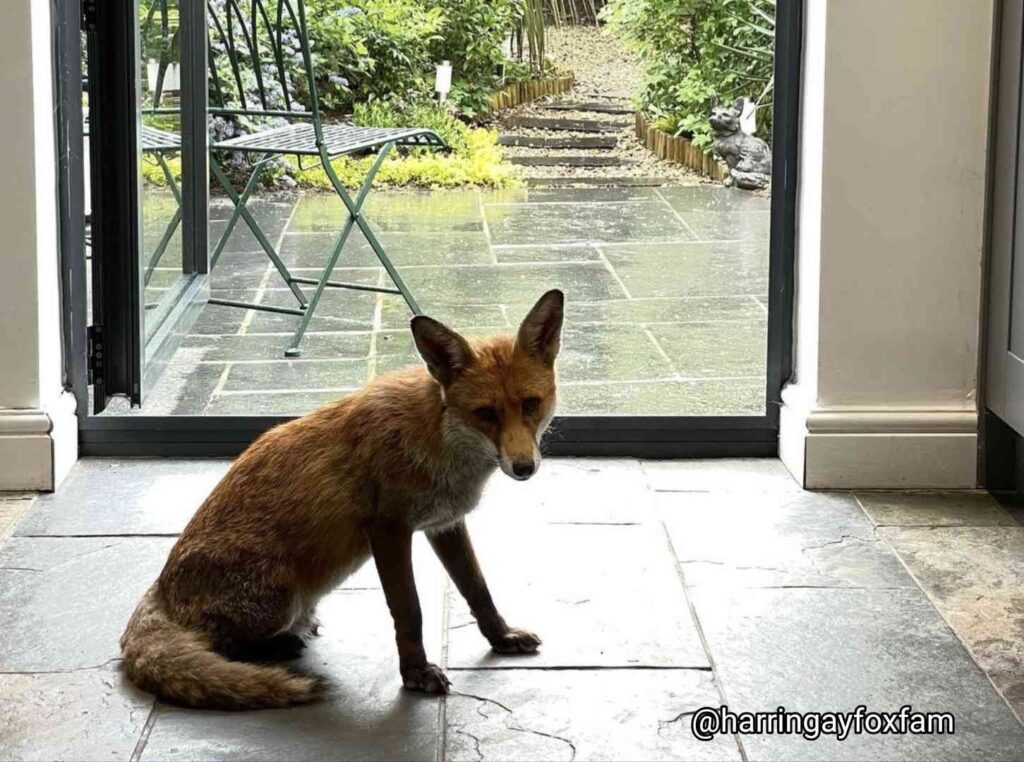How do I deal with a foxy intruder?

If you unexpectedly find a foxy visitor inside your house, there could be a variety of reasons for this.
In late summer/early autumn juvenile foxes are at the verge of dispersal – they are hungry explore with curiosity as they are learning to be independent. So your visitor may be an opportunistic young fox that came in through the open back door, looking for food or shelter If you come across a fox in your home remain calm, move slowly, lower your gaze and talk to them in a calm voice. Open the nearest exit door and move away from the fox (potentially even into another room), so the fox knows you are no threat. Don’t corner the fox. You could place food outside to tempt the fox to leave your home and then close the door once the fox has gone outside.
It is very helpful if you can take a picture or video of your foxy intruder, so the fox can be assessed by rescuers if needed.
Sometimes an ill or injured fox is seeking shelter in the home of a person they trust. So if a fox is not phased by your presence or very slow and reluctant to move, the fox may be ill, injured or both and needs help. Just recently somebody emailed me about two juveniles foxes that both have mange and did seek shelter the person’s utility room. As the temperatures are plummeting and there had been relentless rain, these foxes that have barely got any fur left to protect them from the elements are looking for somewhere warm and dry to rest up. To top it off those two youngsters had only recently lost their mum (found dead in the garden), just at a crucial time when mum was going to take the youngsters on a tour of the neighbourhood, showing them the safe places to forage or rest up. As a result the foxes were underweight and parasitic mites had taken over their bodies causing the dreaded (and if left untreated deadly) mange. I advised on supplementary feeding these foxes to build them up and be able to give them mange meds disguised inside food and referred the person to my post on setting up a cheap fox shelter in the garden

A few years ago I was called to assist with a very docile fox that kept on going inside the living room of a lady who was feeding him. This fox was called Timmi ventured inside the house through the door that had been left ajar without being encouraged by food to come on. Timmi was very quiet and shy and slept for hours on the sofa not flinching even if people approached him. This is extremely unusual for a wild fox as they are always alert, often sleeping with one eye open and even when asleep, still moving their ears, and bolting when there is an unexpected sound or motion detected. It was obvious that something was wrong with Timmi and he needed to be rescued to be assessed by a vet. After Timmi was rescued it turned out that he had deep bite wounds (most likely from a dog) that were infected and he had indeed sought shelter and ask his guardian for help.

In rare cases if a fox that has ventured inside is not reacting to your presence and not showing the instinctual fear foxes have of humans, the fox may suffer from toxoplasmosis, a parasitic infection that can lead to brain damage. If this is the case, the fox may need rescuing to be treated and kept safe. It is advisable to monitor the fox and log visiting times. Record a video that shows how the fox moves, so the fox can be assessed virtually by a rescuer. Toxoplasmosis foxes seem not quite there and often move in a slow and uncoordinated way, are circling or even having seizures. You can support the fox by providing some food and water. Food will be used as bait in a trap, should the fox need rescuing. Provide food, water and potentially shelter (a cardboard box filled with straw) away from the house. A blood test at the vet can determine if the fox suffers from toxoplasmosis. Mild cases are treatable although brain damage can’t be reversed. Some foxes recover and can be re-released in the wild: others need to be “kept safe” and live in one of the few wildlife rehabilitation centres that offer a vulnerable wild fox a retirement.

Sadly, there is a trend on social media with people posting pictures and videos of foxes inside their home, often enticing the foxes into the house by feeding them indoors. This inspires copycat behavior by other people who also use wild foxes as “props” for their social media pics and video clips. This is such a shame as it trains foxes to associate indoor spaces with being fed. This does not serve foxes well as many people who do not like foxes and/or are scared of them, would interpret a fox entering their home as dangerous predatory behaviour and may call “pest” control to get the fox killed. Never feed a fox indoors and never hand-feed a fox. This is responsible behavior that will help to keep the fox you wish to support safe. Cherish the moments you have in the presence of a wild animal without trying to train and tame them, so that you can hand-feed or touch them. It is so much more rewarding when interactions with a wild fox happens on their terms, rather than being manipulated by the humans who want to claim “ownership” of a fox by threating them like a pet.

